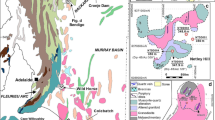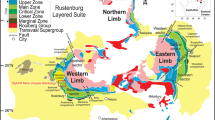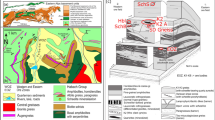Abstract
The Söğüt kaolinite deposits at Çaltı, İnhisar, and Küre, Turkey, are an important source of raw materials for the ceramics industry of that country, but no detailed mineralogical or geochemical characterizations of these economically important materials have been carried out to date. The purpose of this study was to fill this gap by performing mineralogical, geochemical, and isotopic characterizations of these kaolinite deposits which occur within Paleozoic granite-granodiorite complexes that are crosscut by aplite and pegmatite dikes, and overlain by Neogene sedimentary units. These units are dominated by quartz veins and networks of subvertical fractures and weak zones that were invaded by hydrothermal fluids, resulting in their kaolinization and silicification. Altered units and related host rocks were examined using polarized-light microscopy, X-ray diffractometry, scanning electron microscopy, infrared spectroscopy, and chemical and isotopic methods. Feldspar crystals are either sericitized or kaolinized, and mica exhibits partial chloritization; Fe-Ti-Mn oxides occur within fractures. Kaolinite crystals occur in authigenic vermiform or plate-like stacked forms, having contacts with resorbed feldspar crystals which locally exhibit thick, platy, and subparallel orientations relative to microfractures, the pathways for hydrothermal-fluid injection. Altered feldspar relicts are associated mainly with kaolinite, smectite, quartz crystals, and illite/mica. Increase in (Al+Fe)/Si in the kaolinized units (relative to host-rock granite and granodiorite complexes and silicification), depletion of Ba+Rb, and a negative Eu anomaly reveal that the alteration of feldspar by hydrothermal fluid, the character of which was determined from O- and H-isotopic values, resulted in the precipitation of kaolinite. Thus, the Söğüt kaolinite deposit possibly formed by hydrothermal alteration and a feldspar dissolution-precipitation mechanism in both the granite-granodiorites complexes and related overlying sedimentary units under acidic environmental conditions, which developed via depletion of the soluble elements Na and Ca.
Similar content being viewed by others
References
Akıncı, O. (1968) Bilecik bölgesi kaolin yatakları ve civarının jeolojisi, kaolinlerin seramik özellikleri. Maden Tetkik ve Arama Enstitüsü Dergisi, 70, 67–82.
Aksoy, H. (1978) Geology and clay deposits of the Küreköy-Inhisar (Söğüt-Bilecik). Yüksek Mühendislik Tezi, O.D.T.Ü. Fen Bilimleri Enstitüsü, Ankara, 65 pp. (Unpublished MSc thesis).
Aldaham, A.A. and Morad, S. (1986) Mineralogy and chemistry of diagenetic clay minerals in Proterozoic sandstones from Sweden. American Journal of Science, 286, 29–80.
Anderson, T.F. and Arthur, M.A. (1983) Stable isotopes of oxygen and carbon and their application to sedimentologic and paleoenvironmental problems. Pp. 1–151 in: Stable Isotopes in Sedimentary Geology (M.A. Arthur, T.F. Anderson, I.R. Kaplan, J. Veizer, and L.S. Land, editors). Short Course Notes, 10, Society of Economic Paleontologists and Mineralogists.
Arslan, M., Kadir, S., Abdioğlü, E., and Kolaylı, H. (2006) Origin and formation of kaolin minerals in saprolite of Tertiary alkaline volcanic rocks, Eastern Pontides, NE Turkey. Clay Minerals, 41, 599–619.
Berner, E.K. and Berner, R.A. (1996) Global Environment: Water, Air, and Geochemical Cycles. Prentice-Hall, New Jersey, USA, 376 pp.
Bobos, I., Duplay, J., Rocha, J., and Gomes, C. (2001) Kaolinite to halloysite-7 Å transformation in the kaolin deposit of São vicente de Pereira, Portugal. Clays and Clay Minerals, 49, 596–607.
Boulais, P., Valley, J.M., Choux, J.E., Fourcade, S., and Martineau, F. (2000) Origin of kaolinization in Brittany (NW France) with emphasis on deposits over granite: stable isotopes (O, H) constraints. Chemical Geology, 168, 211–223.
Brindley, G.W. (1980) Quantitative X-ray analysis of clays. Pp. 411–438 in: Crystal Structures of Clay Minerals and their X-ray Identification (G.W. Brindley and G. Brown, editors). Monograph 5, Mineralogical Society, London.
Bristow, C.M. (1977) A review of the evidence for the origin of the kaolin deposits in S.W. England. Proceedings of the 8th International Kaolin Symposium and Meeting on Alunite, Madrid-Rome, K-2, 1–19.
Chen, P.Y., Lin, M.L., and Zheng, Z. (1997) On the origin of the name kaolin and the kaolin deposits of the Kauling and Dazhou areas, Kiangsi, China. Applied Clay Science, 12, 1–25.
Çoğulu, E., Delaloye, E., and Chessex, R. (1965) Sur l’age de quelques rockes intrusives acides de la region Eskişehir, Turquie. Archives des Sciences Genève, 18, 692–699.
Delaloye, M. and Bingöl, E. (2000) Granitoids from western and northwestern Anatolia: Geochemistry and modeling of Geodynamic Evolution. International Geology Review, 42, 241–263.
Demirkol, C. (1977) Üzümlü-Tuzaklı (Bilecik ili) dolayının jeolojisi. Tatbiki Jeoloji Kürsüsü Arşivi, 20, 9–16.
Duru, M., Gedik, İ. and Aksay, A. (2002) 1:100.000 ölçekli Türkiye Jeoloji Haritası. No. 37. The General Directorate of Mineral Research, Ankara.
Ehrenberg, S.N. (1991) Kaolinized, potassium-leached zones at the contacts of the Garn Formation, Haltenbanken, mid-Norwegian continental shelf. Marine and Petroleum Geology, 8, 250–269.
Ekosse, G. (2001) Provenance of the Kgwakgwe kaolin deposit in southeastern Bostwana and its possible utilization. Applied Clay Science, 20, 137–152.
Eren, M. and Kadir, S. (1999) Colour origin of upper Cretaceous pelagic red sediments within the Eastern Pontides, northeast Turkey. International Journal of Earth Sciences, 88, 593–595.
Exley, C.S. (1976) Observations on the formation of kaolinite in the St. Austell Granite, Cornwall. Clay Minerals, 11, 51–63.
Farmer, V.C. and Palmieri, F. (1975) The characterization of soil minerals by infrared spectroscopy. Pp. 573–671 in: Soil Components, vol. 2, Inorganic Components (J.E. Gieseking, editor). Springer-Verlag, New York.
Garbarino, C., Masi, U., Padalino, G., and Palomba, M. (1994) Geochemical features of the kaolin deposits from the Sardinia (Italy) and genetic implications. Chemie der Erde, 54, 213–233.
Gençoğlu, H.(1988) Yeniköy-Küre-Çaltı (Bilecik Söğüt) yöresi Neojen baseninin sedimanter jeolojik ve mineralojik-petrografik incelenmesi. Yüksek Mühendilik Tezi, Hacettepe Üniversitesi, Ankara, 147 pp. (unpublished MSc thesis).
Gençoğlu, H., Bayhan, H., and Yalçın, H. (1989) Bilecik-Söğüt Yöresi kaolinit yataklarının mineralojisi ve kökeni, IV. Ulusal Kil Sempozyumu. C.Ü., Sivas, 97–110.
Gilkes, R.J. and Suddhiprakarn, A. (1979a) Biotite alteration in deeply weathered granite. I. Morphological, mineralogical, and chemical properties. Clays and Clay Minerals, 27, 349–360.
Gilkes, R.J. and Suddhiprakarn, A. (1979b) Biotite alteration in deeply weathered granite. II. The oriented growth of secondary minerals. Clays and Clay Minerals, 27, 361–367.
Göncüoğlu, M.C., Turhan, N., Şentürk, K., Uysal, Ş., Özcan, A., and Işık, A. (1996) Orta Sakarya’da Nallıhan-Sarıcakaya arasındaki yapısal jeolojik özellikleri. MTA Report No. (Unpublished).
Göncüoğlu, M.C., Turhan, N., Şentürk, K., Özcan, A., Uysal, Ş., and Yılmaz, M. (2000) A geotraverse across northwestern Turkey: tectonic units of central Sakarya region and their tectonic evolution. Pp. 139–161 in: Tectonics and Magmatism in Turkey and Surrounding Area (E. Bozkurt, J.A. Winchester, and J.D.A. Piper, editors). Special Publications, 173, Geological Society, London.
Gouveia, M.A., Prudencio, M.L., Figueiredo, M.O., Pereira, L.C.J., Waerenbrogh, J.C., Morgado, I., Pena, T., and Lopes, A. (1993) Behavior of REE and other trace and major elements during weathering of granitic rocks, Evora, Portugal. Chemical Geology, 107, 293–298.
Gürel, A. and Kadir, S. (2008) Geology and mineralogy of Late Miocene clayey sediments in the southeastern part of the central Anatolian volcanic province, Turkey. Clays and Clay Minerals, 56, 307–321.
Harris, W.G., Zelazny, L.W., Baker, J.C., and Martens, D.C. (1985a) Biotite kaolinization in Virginia Piedmont soils: I. Extent, profile trends, and grain morphological effects. Soil Science Society of America Journal, 49, 1290–1297.
Harris, W.G., Zelazny, L.W., and Bloss, F.D. (1985b) Biotite kaolinization in Virginia Piedmont soils: II. Zonation in single grains. Soil Science Society of America Journal, 50, 810–819.
Inoue, A. (1995) Formation of clay minerals in hydrothermal environments. Pp. 268–329 in: Origin and Mineralogy of Clays: Clays and the Environment (B. Velde, editor). Springer-Verlag, Berlin.
Juteau, T., Bingöl, F., Noack, Y., and Whitechurch, H. (1978) 38. Preliminary results: mineralogy and geochemistry of alteration products in leg 45 basement samples. Initial Reports of the Deep Sea Drilling Project, XLV, 613–645, Washington.
Kadir, S. and Akbulut, A. (2009) Mineralogy, geochemistry and genesis of the Taşoluk kaolinite deposits in pre-Early Cambrian metamorphites and Neogene volcanites of Afyonkarahisar, Turkey. Clay Minerals, 44, 89–112.
Kadir, S. and Karakaş, Z. (2002) Mineralogy, chemistry and origin of halloysite, kaolinite and smectite from Miocene ignimbrites, Konya, Turkey. Neues Jahrbuch fur Mineralogie, Abhandlungen, 177, 113–132.
Kadir, S., Önen-Hall, P., Aydin, S.N., Yakicier, C., Akarsu, N., and Tuncer, M. (2008) Environmental effect and genetic influence: a regional cancer predisposition survey in the Zonguldak region of northwest Turkey. Environmental Geology, 54, 391–409.
Kalyoncuoğlu, A., Özkan, Ü. and Aktaran, İ. (1977) Çatlı-Küre-Yeniköy (Bilecik-Söğüt) dolaylarının refrakter kil ve kaolen aramaları ara raporu. MTA Rapor No. 1310, 85 pp. (unpublished).
Kibici, Y. (1982) Sarıcakaya (Eskişehir ili) masifinin jeolojisi, petrografisi ve petrolojik etüdü, masife ilişkin kalay araştırması. Eskişehir Devlet Mühendislik ve Mimarlık Akademisi, Doktora Tezi, 224 pp.
Kitagawa, R. and Köster, H.M. (1991) Genesis of the Tirschenreuth kaolin deposit in Germany compared with the Kohdachi kaolin deposit in Japan. Clay Minerals, 26, 61–79.
Kristmannsdottir, H. (1978) Alteration of basaltic rocks by hydrothermal activity at 100–300°C. Proceedings of International Clay Conference, Oxford, pp. 359–367.
Leinemann, C.P., Taillefert, M., Perret, D., and Gaillard, J.F. (1997) Association of cobalt and manganese in aquatic systems: chemical and microscpic evidence. Geochimica et Cosmochimica Acta, 61, 1437–1466.
MacEwan, D.M.C. and Wilson, M.J. (1980) Interlayer and intercalation complexes of clay minerals. Chapter 3 in: Crystal Structures of Clay Minerals and their X-ray Identification (G.W. Brindley and G. Brown, editors). Monograph 5, Mineralogical Society, London.
Maclean, W.H. and Kranidiotis, P. (1987) Immobile elements as monitors of mass transfer in hydrothermal alteration: Phelps Dodge massive sulfide deposits, Matagami, Quebec. Economic Geology 2, 951–962.
Madejová, P., Komadel, P., and Čičel, B. (1992) Infrared spectra of some Czech and Slovak smectites and their correlation with structural formulas. Geologica Carpathica Clays, 1, 9–12.
Maiza, P.J., Pieroni, D., and Marfil, S.A. (2003) Geochemistry of hydrothermal kaolins in the SE area of Los Menucos, Province of Rio Negro, Argentina. Pp. 123–130 in: A Clay Odyssey (E.A. Dominguez, G.R. Mas and F. Gravero, editors). Elsevier, Amsterdam.
Meunier, A. (1995) Hydrothermal alteration by veins. Pp. 247–267 in: Origin and Mineralogy of Clays, Clays and the Environment (B. Velde, editor). Springer-Verlag, Berlin.
Meunier, A. (2005) Clays. Springer-Verlag, Berlin, Heidleberg, Germany, 472 pp.
Meunier, A. and Velde, B. (2004) Illite, Origin, Evolution and Metamorphism. Springer-Verlag, Berlin, Heidelberg, New York, 286 pp.
Moore, D.M. and Reynolds, R.C. (1989) X-ray Diffraction and the Identification and Analysis of Clay Minerals. Oxford University Press, New York, 332 pp.
Nagasawa, K. (1978) Kaolin minerals. Pp. 189–219 in: Clays and Clay Minerals of Japan (T. Sudo and S. Shimoda, editors). Developments in Sedimentology, 26, Elsevier, Tokyo.
Njoya, A., Nkoumbou, C., Grosbois, C., Njopwouo, D., Njoya, D., Courtin-Nomade, A., Yvon, J., and Martin, F. (2006) Genesis of Mayouom kaolin deposit (western Cameroon). Applied Clay Science, 32, 125–140.
Parry, W.T., Ballantyne, J.M., and Jacobs, D.C. (1984) Geochemistry of hydrothermal sericite from Roosevelt Hot Springs and the Tintic and Santa Rita porphyry copper systems. Economic Geology, 79, 72–86.
Rebertus, R.A., Weed, S.B., and Buol, S.W. (1986) Transformations of biotite to kaolinite during saprolite-soil weathering. Soil Science Society of America Journal, 50, 810–819.
Robbins, E.I., Agostino, J.P.D., Ostwald, J., Fanning, D.S., Carter, V., and Van Hoven, R.L. (1992) Manganese nodules and microbial oxidation of manganese in the Huntley Meadows Wetland, Virginia, USA. Catena Supplement, 21, 179–202.
Rollinson, H.R. (1993) Using Geochemical Data: Evaluation, Presentation Interpretation. John Wiley and Sons Inc., New York, 352 pp.
Russell, J.D. (1987) Infrared methods. Pp. 133–173 in: A Handbook of Determinative Methods in Clay Minerals (M.J. Wilson, editor). Blackie, Glasgow, UK.
Savin, S.M. and Epstein, S. (1970) The oxygen and hydrogen isotope geochemistry of clay minerals. Geochimica et Cosmochimica Acta, 34, 25–42.
Schwertmann, U. and Murad, E. (1983) Effect of pH on the formation of goethite and hematite from ferrihydrite. Clays and Clay Minerals, 31, 277–284.
Schwertmann, U. and Taylor, R.M. (1989) Iron oxides. Pp. 379–438 in: Minerals in Soil Environments (J.B. Dixon and S.B. Weed, editors). Soil Science Society of America, Madison, Wisconsin, USA.
Şengör, A.M.C. (1979) The North Anatolian Transform Fault: its age, offset and tectonic significance. Journal of the Geological Society, 13, 268–282.
Şengör, A.M.C. and Yılmaz, Y. (1981) Tethyan evolution of Turkey: a plate tectonic approach. Tectonophysics, 75, 181–241.
Sheppard, S.M.F. (1986) Characterization and Isotopic Variations in Natural Waters. Pp. 141–162 in: Stable Isotopes in High Temperature Geological Processes (J.W. Valley, H.P. Taylor, and J.R. O’Neil, editors). Reviews in Mineralogy, 16, Mineralogical Society of America, Washington, D.C.
Sheppard, S.M.F. and Gilg, H.A. (1996) Stable isotope geochemisty of clay minerals. Clay Minerals, 31, 1–24.
Siddique, M.A. and Ahmed, Z. (2008) Geochemistry of the kaolin deposits of Swat (Pakistan). Chemie der Eder Geochemistry, 68, 207–219.
Srasra, E., Bergaya, F., and Fripiat, J.J. (1994) Infrared spectroscopy study of tetrahedral and octahedral substitutions in an interstratified illite-smectite clay. Clays and Clay Minerals, 42, 237–241.
State Planning Organization of Turkey (2001) State Planning Organization of Turkey, 8th Five-Year Development Plan, Mining Special Expert Commission Report, Volume 1, Industrial Minerals Sub-Commission, Ceramic clays—Kaolin—Pyrophyllite—Wollastonite—Talc Group, Ankara, 224 pp. (https://doi.org/ekutup.dpt.gov.tr/madencil/sanayi-ha/oik618.pdf)
Stock, L. and Sikora, W. (1976) Transformation of micas in the process of kaolinization of granites and gneisses. Clays and Clay Minerals, 24, 156–162.
Taylor, H.P. (1974) The application of oxygen and hydrogen isotope studies to problems of hydrothermal alteration and ore deposition. Economic Geology, 69, 843–883.
Taylor, H.P. (1979) Oxygen and hydrogen relationships in hydrothermal mineral deposits. Pp. 236–277 in: Geochemistry of Hydrothermal Ore Deposits (H.L. Barnes, editor) 2nd edition. Wiley, New York.
Taylor, S.R. and McLennan, S.M. (1985) The Continental Crust: Its Composition and Evolution. Blackwell, Oxford, 312 pp.
Van der Marel, H.W. and Beutelspacher, H. (1976) Atlas of IR Spectroscopy of Clay Minerals and Their Admixtures. Elsevier, Amsterdam, 396 pp.
Wilson, M.J. (1987) X-ray powder diffraction methods. Pp. 26–98 in: A Handbook of Determinative Methods in Clay Mineralogy (M.J. Wilson, editor). Blackie, Glasgow, UK.
Yui, T.F. and Chang, S.S. (1999) Formation conditions of vesicle/fissure-filling smectites in Penghu basalts: a stabe-isotope assessment. Clay Minerals, 34, 381–393.
Ziegler, K. (2006) Clay minerals of the Permian Rotliegend Group in the North Sea and adjacent areas. Clay Minerals, 41, 355–393.
Zielinski, R.A. (1985) Element mobility during alteration of silicic ash to kaolinite - a study of tonstein. Sedimentology, 32, 567–579.
Author information
Authors and Affiliations
Corresponding author
Rights and permissions
About this article
Cite this article
Kadir, S., Kart, F. The occurrence and origin of the söğüt kaolinite deposits in the Paleozoic Saricakaya granite-granodiorite complexes and overlying Neogene sediments (Bilecik, northwestern Turkey). Clays Clay Miner. 57, 311–329 (2009). https://doi.org/10.1346/CCMN.2009.0570304
Received:
Revised:
Published:
Issue Date:
DOI: https://doi.org/10.1346/CCMN.2009.0570304




